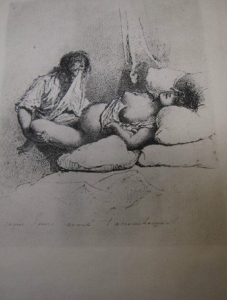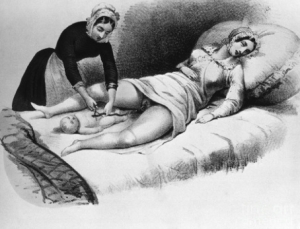Postpartum Care in 19th Century America
One of the female characters in Widow Walk, Emmy Evers, receives postpartum care after suffering a miscarriage. Emmy was cared for by a male doctor and some female caretakers, whose greatest concern is her postpartum fever as they had seen so many women perish when this was present.
 Because she was hemorrhaging, the physician who attended her understood the need to evacuate her uterus of “retained placenta” to prevent Emmy from bleeding to death. He likely used his bare, unwashed hands and may have caused her infection.
Because she was hemorrhaging, the physician who attended her understood the need to evacuate her uterus of “retained placenta” to prevent Emmy from bleeding to death. He likely used his bare, unwashed hands and may have caused her infection.- Hand washing was not a common practice until germ theory evolved later that century. When the correlation between germs and infection was finally understood and taught, physicians and nurses in surgery and deliveries began washing their hands with diluted carbolic acid solutions and sometimes wore reusable gloves.
- One could tell if a person was a nurse or physician who performed surgeries because of the swelling and red chafing the carbolic acid caused on the hands.
- When Emmy became ill with postpartum sepsis, the physician treated her with poultices, mustard plasters, alcohol cooling baths, opiates and constant and vigilant observation. Her caretakers kept notes about her excretions and the odor of her vaginal discharge. Antibiotics were not discovered or invented yet.
- For the pain, she was given laudanum, an opiate still prescribed today.
Etching of French Victorian Era Childbirth
 Women’s health care, specifically as it relates to childbirth and postpartum care, has come a long way since the 1800’s
Women’s health care, specifically as it relates to childbirth and postpartum care, has come a long way since the 1800’s- At the time the Widow Walk events take place, a typical childbirth would have had the following characteristics:
- No men would be present, including husbands. Male doctors were invited in some circumstances, such as malposition of the fetus, which necessitated “repositioning.”
- Births were attended by midwives, if your were lucky enough to have yours available at the time of birth or family members or friends who were female
- Medicinal pain relief was not an option; women managed the pain on their own and with the assistance of their midwife or experienced female family members and friends
- The event would have taken place at home, not in a hospital or doctor’s office
- Women and babies who survived the ordeal were considered strong, but many died of “childbirth complications” which could have been anything from a fetal position problem that caused the baby to get stuck, to “postpartum fever” caused by endometrial infection and bacterial sepsis.
- Was Emmy’s survival the result of being one of the strong ones, or the result of her being one of the lucky ones, having skilled caretakers by her side?
Share your thoughts in the comments section below.
Read the first chapters of my award-winning novel, Widow Walk, for free right now. Plus, join the Land Rush to enter a drawing for a chance to win one of these fabulous prizes: a three-day writing retreat at the gorgeous Whidbey Island Writer’s Refuge, a $100 Amazon gift card, a book club party pack with wine and chocolate, and more!